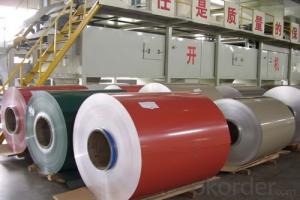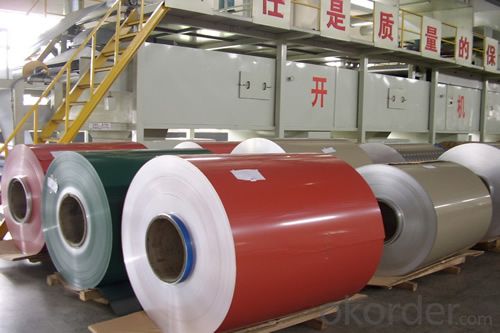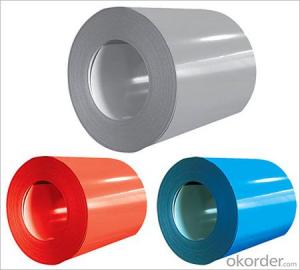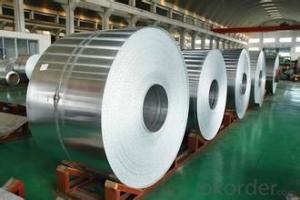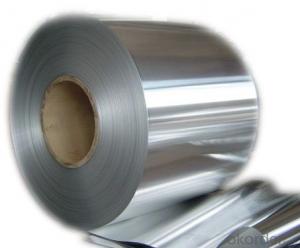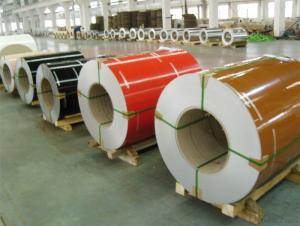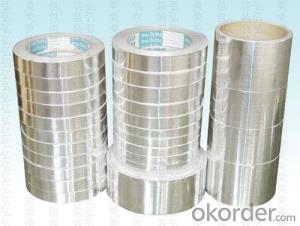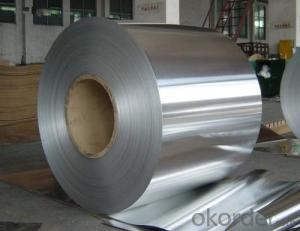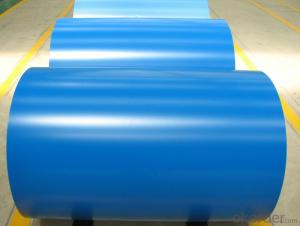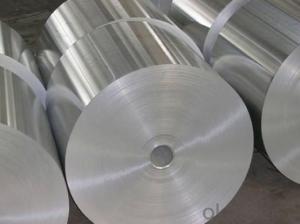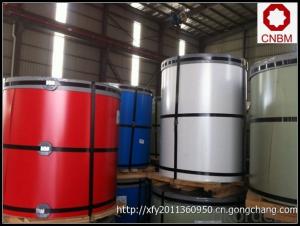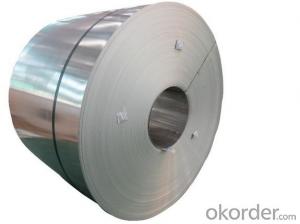Best Line Aluminum Coil for Coated Aluminum Composite Panel
- Loading Port:
- Shanghai
- Payment Terms:
- TT OR LC
- Min Order Qty:
- 2 m.t.
- Supply Capability:
- 50000 m.t./month
OKorder Service Pledge
OKorder Financial Service
You Might Also Like
Specification
Coated Aluminium Coil/Roll For Aluminium Composite Panel
Description
Alloy | 1060, 1100, 3003, 8011, etc. |
Temper | H16, H18, H24, H26, H28 |
Thickness | From 0.05mm to 3.0mm |
Width | Standard width:1240mm |
Special width:1300mm, 1520mm, 1570mm, 1595mm | |
Diameter | Standard dia:1200mm |
Interior dia:150mm,405mm,505mm | |
Weight | 2.5 T/coil,3.0 T/coil |
Coating | PE, PVDF, ACRYLIC |
Surface | Embossed, mill finish, coated |
Color | AS to code RAL |
Gloss | 10-90%(EN ISO-2813:1994) |
Coating Thickness | PE: more than 18 micron |
PVDF: more than 25 micron | |
Coating Hardness(pencil resistance) | More than 2h |
Coating adhesion | 5J (EN ISO-2409:1994) |
Impact Resistance | No peeling or cracking(50 kg/cm,ASTMD-2794:1993) |
Flexibility(T-bend) | 2T |
MEK resistance | More than 100 |
Advantage | 1.High temperature resistant 2.Weathering resistant 3.Scrubbing resistant 5.Acid or alkali proof 6. Fireproof 7.Light weight material is easy to construct and install |
Out package | Wooden splint with export standard |
Application | ACP, wall cladding, facades, roofs and canopies, ceilings, signboards, blind window, display platforms, electrical panels, etc |
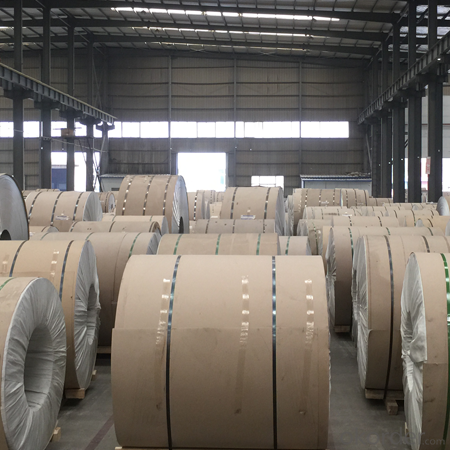
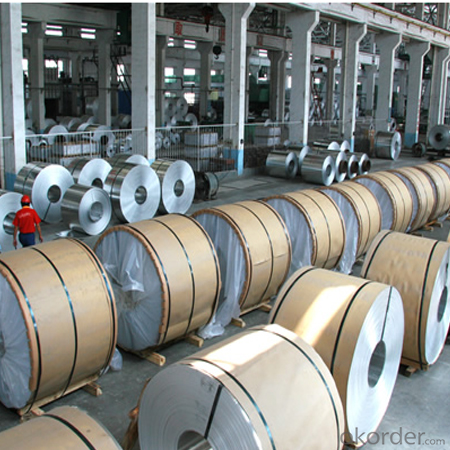
Manufacturing
Decoiler → Accumulator →Tension Leveler →Acid & Alkali Cleaner → Rinse →Conversion Treatment → Priming coater →Infrared Curing Oven →Main coater →Floatation Curing Oven →Strippable Film Applicator → Exit Accumulator → Recoiler
FAQ
--Q: Do you provide free samples?
--A: Yes, free samples will be sent to you on freight at destination.
--Q: Can I get your latest products catalogue?
--A: Yes, it will be sent to you in no time.
--Q: What is the MOQ?
--A: 2 tons
--Q: What are your payment terms?
--A: We accept L/C, T/T.
--Q: What kinds of alloy can you supply?
--A: 1000 series: 1050, 1060, 1070, 1100, 1145, 1200
3000 series: 3003, 3004, 3105, 3104
5000 series: 5052, 5083, 5754, 5182
6000 series: 6061, 6063, 6062, 6063
8000 series: 8011, 8021
--Q: What kinds of temper can you supply?
--A: O-H112: O,H12,H14,H16,H18,H22,H24,H26,H,32,H34,H111,H112
T3, T4, T6
- Q: What are the common sizes and thicknesses of aluminum coils?
- Common sizes and thicknesses of aluminum coils vary depending on the specific application and industry. However, there are some standard sizes and thicknesses that are commonly used across various industries. In terms of size, aluminum coils typically range from around 12 inches to 72 inches in width. This range allows for flexibility in accommodating different production processes and equipment. The length of the coils can vary as well, but it is often in the range of 1000 to 6000 feet. As for thickness, aluminum coils come in various gauges, which are commonly measured in inches or millimeters. The most commonly used thicknesses for aluminum coils are between 0.019 inches (0.48 mm) and 0.125 inches (3.18 mm). These thicknesses are suitable for a wide range of applications, including roofing, construction, automotive, and manufacturing. It is important to note that these are general guidelines, and the specific size and thickness requirements may vary depending on the intended use of the aluminum coils. Additionally, custom sizes and thicknesses can also be manufactured to meet specific project requirements.
- Q: What are the common installation methods for aluminum coils?
- Aluminum coils can be installed using various methods, each with its own advantages and applications. 1. Direct Attachment: To install aluminum coils, one can directly attach them to the desired surface, like a wall or roof. The specific method of attachment, whether it's screws, nails, or adhesive, depends on the application and surface condition. This method is commonly used for exterior applications such as siding and roofing. 2. Coil Stock Installation: Another method involves cutting the aluminum coil into smaller pieces known as coil stock, which are then installed individually. This method is ideal for projects that require a customized fit, such as wrapping window frames or creating trim pieces. Precise measurement and cutting are crucial for a perfect fit. 3. Coil Over Existing Material: In certain cases, aluminum coils can be installed directly over existing materials like old siding or roofing. This cost-effective method allows for updating the appearance of a building without the need for complete removal and replacement. It also saves time and labor compared to other methods. 4. Coil Cladding: Coil cladding is a popular installation method where the aluminum coil is wrapped around an existing structure, such as a column or beam. This provides both protection and aesthetic appeal to the structure. In architectural applications, coil cladding is often used to enhance the appearance of buildings and add a layer of protection to structural elements. It's important to consider the specific requirements of the application, surface condition, and desired outcome when choosing an installation method for aluminum coils. Consulting a professional or following manufacturer guidelines is recommended to ensure proper installation, maximize longevity, and maintain optimal performance of the aluminum coils.
- Q: a) Although Aluminium is a reactive metal, it is used to make door frames and window frames.b) Although Aluminium conducts heat, it is used to make blankets, which are good thermal insulators.
- aluminum is cheap . easy to work with and good looking , because of this it is used to make door frames etc.
- Q: Can aluminum coils be used for electrical transformers?
- Indeed, electrical transformers can utilize aluminum coils. The application of aluminum as a material for transformer coils is attributed to its superior electrical conductivity and cost-effectiveness in comparison to copper. Traditionally, copper has been favored for transformer windings; nevertheless, the utilization of aluminum has gained traction in recent times due to its lighter weight and more affordable price. Additionally, aluminum coils offer advantages in terms of thermal conductivity, as they efficiently dissipate heat in contrast to copper. Nevertheless, it is crucial to take into account the specific demands and design considerations of the transformer, as the decision between aluminum and copper coils may hinge upon factors such as voltage, current, size, and insulation requirements.
- Q: Can aluminum coils be used for heat dissipation purposes?
- Aluminum coils prove to be highly effective in the dissipation of heat. Due to its exceptional heat conductivity and minimal thermal resistance, aluminum serves as an excellent medium for transferring heat from a source and releasing it into the surrounding environment. Various applications, including refrigeration, air conditioning, radiator systems, and heat exchangers, commonly employ aluminum coils. These coils are designed to optimize the available surface area for heat transfer, thereby ensuring efficient cooling and dissipation. Moreover, aluminum possesses the advantages of being lightweight and resistant to corrosion, making it a practical choice for heat dissipation across diverse industries. Overall, aluminum coils emerge as a dependable and efficient solution for heat dissipation purposes.
- Q: Are aluminum coils compatible with different joining methods?
- Yes, aluminum coils are compatible with different joining methods. Aluminum is a highly versatile metal that can be joined using various techniques such as welding, brazing, soldering, and mechanical fastening. The choice of joining method depends on the specific application and the desired properties of the joint. Welding is commonly used to join aluminum coils as it provides a strong and durable bond. Several welding techniques like MIG (Metal Inert Gas), TIG (Tungsten Inert Gas), and resistance welding can be used depending on the thickness and type of aluminum alloy being joined. Brazing is another effective method for joining aluminum coils. It involves the use of a filler material that has a lower melting point than the base metal, which is heated to create a strong joint. Brazing is commonly used when the aluminum coils need to be joined to other dissimilar metals. Soldering is suitable for joining thin aluminum coils or when a lower temperature method is required. It involves melting a low-temperature alloy (solder) to join the coils together. Soldering is commonly used in electronics and plumbing applications. Mechanical fastening methods such as bolts, screws, rivets, or clips can also be used to join aluminum coils. These methods provide a reliable and removable joint, making them suitable for applications where disassembly may be required. In summary, aluminum coils are compatible with various joining methods, including welding, brazing, soldering, and mechanical fastening. The choice of joining method depends on factors such as the application, the type of aluminum alloy, and the desired properties of the joint.
- Q: Can aluminum coils be used for cladding purposes?
- Certainly, cladding purposes can make use of aluminum coils. The lightweight quality, durability, corrosion resistance, and versatility of aluminum make it a popular choice for cladding. A wide variety of cladding systems, such as curtain walls, rain screens, and facade panels, can be created using aluminum coils. These coils are easy to form, cut, and install, making them a cost-effective and efficient solution for cladding. Moreover, the natural oxide layer of aluminum provides weathering protection and requires minimal maintenance. In conclusion, aluminum coils offer both aesthetic appeal and functional advantages, making them a suitable option for cladding purposes.
- Q: What are the different surface protection options available for aluminum coils?
- Depending on the specific requirements and applications, there are several options available for surface protection on aluminum coils. 1. Applying a paint coating is a common method of surface protection. This creates a protective layer that helps prevent corrosion, oxidation, and damage from environmental factors. Paint coatings also provide aesthetic appeal and come in various colors and finishes. 2. Anodizing is an electrochemical process that creates a durable and corrosion-resistant oxide layer on the aluminum coil's surface. This method enhances the coil's resistance to wear and tear and provides a decorative appearance. Anodized coatings can be clear or colored, offering design flexibility. 3. Another option is applying a protective film made of plastic or vinyl on the surface of the aluminum coil. This film provides temporary protection during transportation, handling, and installation, guarding against scratches and abrasions before being removed. 4. Powder coating involves the electrostatic application of a dry powder onto the aluminum coil's surface. The powder is then cured under heat, resulting in a durable and resilient protective layer. Powder coatings are known for their excellent resistance to chemicals, UV rays, and physical impacts. 5. Cladding, or laminating, involves bonding a protective layer, such as PVC, onto the aluminum coil's surface. This method enhances resistance against scratches, impact, and weathering. Cladding can also provide additional benefits like thermal insulation and noise reduction. When selecting the most suitable surface protection option for aluminum coils, it is important to consider factors such as the intended use, environmental conditions, desired aesthetics, cost, durability, and application requirements.
- Q: This question asks for methods to clean an aluminum coil, which involves understanding the appropriate cleaning materials and techniques to avoid damaging the aluminum.
- <p>To clean an aluminum coil, start by using a soft cloth or sponge dampened with warm water and mild dish soap. Gently wipe the coil to remove dirt and grime. Avoid abrasive materials or harsh chemicals that could scratch the surface. After cleaning, rinse the coil thoroughly with clean water to remove any soap residue. Dry the coil completely to prevent water spots or corrosion. For stubborn stains, consider using a specialized aluminum cleaner, but always follow the manufacturer's instructions and test on a small area first.</p>
- Q: Can aluminum coils be used for electrical connectors?
- Certainly! Electrical connectors can indeed utilize aluminum coils. This metal, widely employed for electrical connectors, boasts exceptional electrical conductivity, a relatively affordable price, and lightweight characteristics. It finds extensive application in diverse electrical domains such as power transmission, distribution systems, electrical motors, and transformers. Nonetheless, it is crucial to prioritize adequate insulation and protection for the aluminum coils to avert corrosion and guarantee enduring dependability for the electrical connections.
Send your message to us
Best Line Aluminum Coil for Coated Aluminum Composite Panel
- Loading Port:
- Shanghai
- Payment Terms:
- TT OR LC
- Min Order Qty:
- 2 m.t.
- Supply Capability:
- 50000 m.t./month
OKorder Service Pledge
OKorder Financial Service
Similar products
Hot products
Hot Searches
Related keywords
